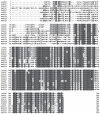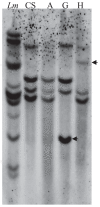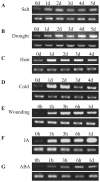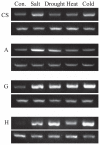Cloning of allene oxide cyclase gene from Leymus mollis and analysis of its expression in wheat-Leymus chromosome addition lines
- PMID: 23641183
- PMCID: PMC3621447
- DOI: 10.1270/jsbbs.63.68
Cloning of allene oxide cyclase gene from Leymus mollis and analysis of its expression in wheat-Leymus chromosome addition lines
Abstract
Leymus mollis (Triticeae; Poaceae) is a useful genetic resource for wheat (Triticum aestivum L.) breeding via wide hybridization to introduce its chromosomes and integrate its useful traits into wheat. Leymus mollis is highly tolerant to abiotic stresses such as drought and salinity and resistant to various diseases, but the genetic mechanisms controlling its physiological tolerance remain largely unexplored. We identified and cloned an allene oxide cyclase (AOC) gene from L. mollis that was strongly expressed under salt stress. AOC is involved in biosynthesis of jasmonic acid, an important signaling compound that mediates a wide range of adaptive responses. LmAOC cDNA consisted of 717 bp, coding for a protein with 238 amino acids that was highly similar to AOCs from barley (Hordeum vulgare) and other monocots. Subcellular localization using Nicotiana benthamiana confirmed it as a chloroplast-localized protein. LmAOC was found to be a multiple-copy gene, and that some copies were conserved and efficiently expressed in wheat-Leymus chromosome addition lines. LmAOC expression was upregulated under drought, heat, cold and wounding stresses, and by jasmonic acid and abscisic acid. Our results suggest that LmAOC plays an important role in L. mollis adaptation to abiotic stresses and it could be useful for wheat improvement.
Keywords: Leymus mollis; LmAOC; allene oxide cyclase; drought stress response; jasmonic acid; salinity; wheat.
Figures






Similar articles
-
Identification of osmotic stress-responsive genes from Leymus mollis, a wild relative of wheat (Triticum aestivum L.).Breed Sci. 2012 Mar;62(1):78-86. doi: 10.1270/jsbbs.62.78. Epub 2012 Mar 20. Breed Sci. 2012. PMID: 23136517 Free PMC article.
-
Chromosome constitution and origin analysis in three derivatives of Triticum aestivum--Leymus mollis by molecular cytogenetic identification.Genome. 2014 Nov;57(11-12):583-91. doi: 10.1139/gen-2014-0161. Epub 2015 Jan 30. Genome. 2014. PMID: 25760775
-
Novel molecular marker-assisted strategy for production of wheat-Leymus mollis chromosome addition lines.Sci Rep. 2018 Oct 31;8(1):16117. doi: 10.1038/s41598-018-34545-x. Sci Rep. 2018. PMID: 30382155 Free PMC article.
-
Drought and salt tolerances in wild relatives for wheat and barley improvement.Plant Cell Environ. 2010 Apr;33(4):670-85. doi: 10.1111/j.1365-3040.2009.02107.x. Epub 2010 Feb 5. Plant Cell Environ. 2010. PMID: 20040064 Review.
-
Insight into the Role of Epigenetic Processes in Abiotic and Biotic Stress Response in Wheat and Barley.Int J Mol Sci. 2020 Feb 21;21(4):1480. doi: 10.3390/ijms21041480. Int J Mol Sci. 2020. PMID: 32098241 Free PMC article. Review.
Cited by
-
Defense Pathways of Wheat Plants Inoculated with Zymoseptoria tritici under NaCl Stress Conditions: An Overview.Life (Basel). 2024 May 20;14(5):648. doi: 10.3390/life14050648. Life (Basel). 2024. PMID: 38792668 Free PMC article. Review.
-
Development and Molecular Cytogenetic Identification of a Novel Wheat-Leymus mollis Lm#7Ns (7D) Disomic Substitution Line with Stripe Rust Resistance.PLoS One. 2015 Oct 14;10(10):e0140227. doi: 10.1371/journal.pone.0140227. eCollection 2015. PLoS One. 2015. PMID: 26465140 Free PMC article.
-
Cloning of wheat keto-acyl thiolase 2B reveals a role of jasmonic acid in grain weight determination.Nat Commun. 2020 Dec 8;11(1):6266. doi: 10.1038/s41467-020-20133-z. Nat Commun. 2020. PMID: 33293512 Free PMC article.
-
Overexpression of Medicago sativa LEA4-4 can improve the salt, drought, and oxidation resistance of transgenic Arabidopsis.PLoS One. 2020 Jun 4;15(6):e0234085. doi: 10.1371/journal.pone.0234085. eCollection 2020. PLoS One. 2020. PMID: 32497140 Free PMC article.
References
-
- Agrawal, G.K., Jwa, N., Agrawal, S.K., Tamogami, S., Iwahashi, H., and Rakwal, R. (2003) Cloning of novel rice allene oxide cyclase (OsAOC): mRNA expression and comparative analysis with allene oxide synthase (OsAOS) gene provides insight into the transcriptional regulation of octadecanoid pathway biosynthetic genes in rice. Plant Sci. 164: 979–992
-
- Clarke, S.M., Cristescu, S.M., Miersch, O., Harren, F.J.M., Wasternack, C., and Mur, L.A.J. (2009) Jasmonates act with salicylic acid to confer basal thermotolerance in Arabidopsis thaliana. New Phytol. 182: 175–187 - PubMed
-
- Colmer, T.D., Flowers, T.J., and Munns, R. (2006) Use of wild relatives to improve salt tolerance in wheat. J. Exp. Bot. 57: 1059–1078 - PubMed
-
- Diatchenko, L., Lau, Y.F.C., Campbell, A.P., Chenchik, A., Moqadam, F., Huang, B., Lukyanov, K., Gurskaya, N., Sverdlov, E.D., and Siebert, P.D. (1996) Suppression subtractive hybridization: a method of generating differentially regulated or tissue-specific cDNA probes and libraries. Proc. Natl. Acad. Sci. USA 93: 6025–6030 - PMC - PubMed
LinkOut - more resources
Full Text Sources
Other Literature Sources
Research Materials
